Birdfinding.info ⇒ Very common throughout the Bahamas, where it may be the most numerous songbird. In Cuba, most reliably found on Cayo Paredón Grande—many birdwatchers visit this island primarily to find it. On Grand Cayman, found throughout the island, but most likely to be found on the eastern side, as at Botanic Park, the Mastic Trail, and North Side. In Florida, vagrants turn up most often in metropolitan Miami parks, especially Bill Baggs State Park.
Thick-billed Vireo
Vireo crassirostris
A mostly Bahamian species with outposts on the Cayman Islands and small islands adjacent to Cuba and Haiti. Common to abundant in dense scrub, brushy woodland, and mangroves.
Inhabits the vast majority of vegetated islands and keys throughout the Lucayan Archipelago from Grand Bahama to Grand Turk. In Cuba, known from keys off of the north-central coast—mainly Cayo Paredón Grande, but also regularly found on Cayo Guillermo and Cayo Coco, and occasionally others. In Haiti, known only from Île de la Tortue, off the northern coast. In the Cayman Islands, resident on Grand Cayman and Cayman Brac.
Not migratory, but dispersive—as a bird that breeds on many small islands must be. Has been a fairly regular vagrant to southeastern Florida, with most records in either spring or fall near the coast from Palm Beach to Key Biscayne.
Identification
An olive vireo with two bold white wingbars, dark eyes, and a distinctive facial pattern: thick, bright yellow loral bars accented below by a thin blackish line, with dark eyes and a broken eyering that is usually white but sometimes yellow.
Overall plumage coloration is somewhat variable. The underparts vary from grayish to yellow (often yellower on the throat and breast), and upperparts vary from gray to bright greenish-olive. The head is usually a shade or two grayer and paler than the back.

Thick-billed Vireo, with typical plain-olive plumage. (Garden of the Gates, Grand Bahama; September 15, 2017.) © Erika Gates
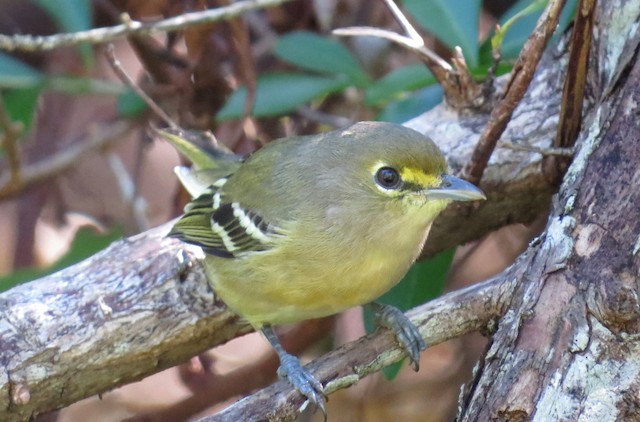
Thick-billed Vireo. (Bill Baggs Cape Florida State Park, Florida; November 5, 2017.) © Michael Woodruff

Thick-billed Vireo, on the gray end of the spectrum. (Taino Beach, Freeport, Grand Bahama; November 24, 2017.) © Erika Gates
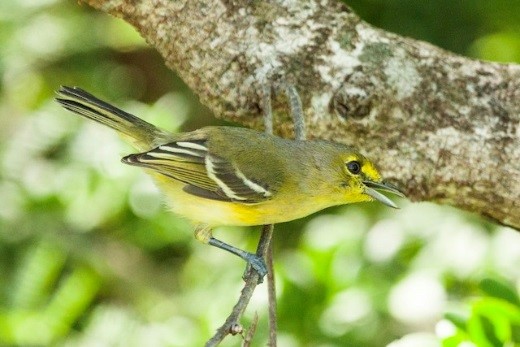
Thick-billed Vireo, on the yellow end of the spectrum. (Seymours, Long Island, Bahamas; October 25, 2017.) © Scott Fischer

Thick-billed Vireo, a plain, pale individual with wingbars broken and indistinct due to molt. (Green Turtle Cay, Bahamas; April 15, 2018.) © David Rudder
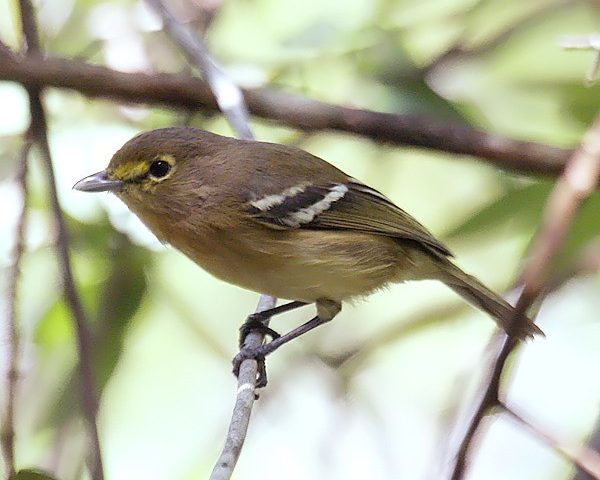
Thick-billed Vireo, with typical plain-olive plumage. (Mastic Trail, Grand Cayman; December 12, 2007.) © Steve Metz

Thick-billed Vireo. (Mastic Trail, Grand Cayman; December 12, 2007.) © Steve Metz

Thick-billed Vireo. (Lucayan National Park, Grand Bahama; February 10, 2018.) © Erika Gates
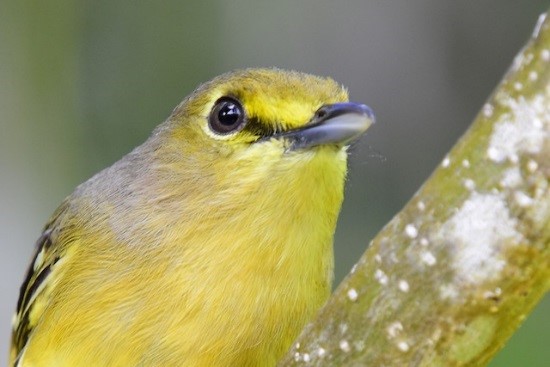
Thick-billed Vireo, a very yellow individual allowing a close study of its distinctive, complex facial pattern. (Green Turtle Cay, Bahamas; April 15, 2018.) © David Rudder
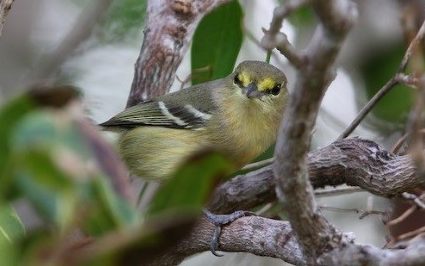
Thick-billed Vireo, frontal view of its bushy yellow loral bars. (South Abaco, Bahamas; January 6, 2013.) © Christoph Moning
Cf. White-eyed Vireo. Immature White-eyed Vireo has a dark eye and is easily confused with Thick-billed Vireo in the Caribbean region. Their overall plumage patterns are similar, including their facial markings, as both have thick yellow supraloral bars and thin eyerings. Thick-billed’s eyering is often white but it can also be yellow, as on White-eyed.
The key difference is that White-eyed has complete, or nearly complete, yellow “spectacles” (referring to the eyering and supraloral bar) whereas Thick-billed’s eyering has a distinct gap above the eye.
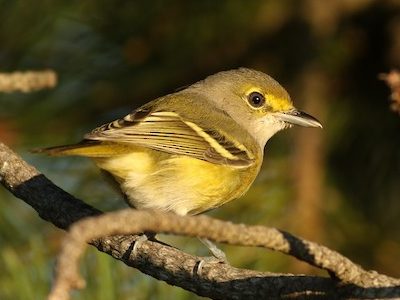
White-eyed Vireo, immature with partly broken eyering. (Prudence Island, Newport, Rhode Island; September 9, 2017.) © Jonathan Eckerson
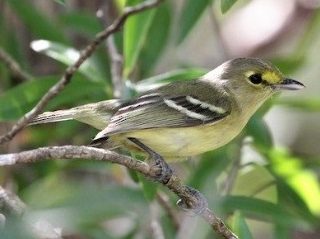
Thick-billed Vireo, showing the diagnostic gap in the eyering above the eye and black loral line. (Botanic Park, Grand Cayman; March 3, 2018.) © Charles Davies
Confusingly, however, some immature White-eyed Vireos also show a broken eyering, but rarely if ever with a gap as pronounced as the one on Thick-billed. (See photo comparison, above.) In addition to the gap in its eyering, Thick-billed typically has a well-defined blackish line on its lore, which frames and enhances the prominence of the yellow supraloral bar.
Thick-billed’s overall coloration is variable, so most details of color and pattern are unreliable field marks. In general, Thick-billed is more evenly olive-colored above and below, lacking sharp contrasts—whereas White-eyed usually shows clear contrasts between its gray nape and olive back and between its yellow flanks and white belly.
Cf. Yellow-throated Vireo. The yellowest Thick-billed Vireos strongly resemble Yellow-throated Vireo under some viewing conditions. If seen well, Thick-billed’s facial pattern, particularly its broken eyering, is unique. Yellow-throated has more clearly defined contrast between colors, with full yellow spectacles, bright yellow throat and breast, white belly, blue-gray lower back and rump, and black-and-white wings and tail.
Cf. Flat-billed Vireo. Flat-billed and Thick-billed Vireos occur within a few miles of each other in northern Haiti. Flat-billed has a yellow supraloral bar that extends over and behind the eye, forming a short eyebrow, and differs further in having a partly pinkish bill and pale eye (but dark in immatures). Flat-billed is also shaped differently, with an inordinately long tail, a peculiar broad, flat head, and an unusual down-turned gape.
Notes
Polytypic species consisting of five recognized subspecies: crassirostris, stalagmium, cubensis, alleni, and tortugae.
Thick-billed has often been considered conspecific with Providencia Vireo, but their vocalizations are entirely different. Moreover, Providencia Vireo is more similar in appearance and geographically closer to the Mangrove Vireo group.
References
Brewer, D. 2018. Thick-billed Vireo (Vireo crassirostris). In Handbook of the Birds of the World Alive (J. del Hoyo, A. Elliott, J. Sargatal, D.A. Christie and E. de Juana, eds.). Lynx Edicions, Barcelona. https://www.hbw.com/node/61242. (Accessed November 14, 2018.)
eBird. 2018. eBird: An online database of bird distribution and abundance. Cornell Lab of Ornithology, Ithaca, N.Y. http://www.ebird.org. (Accessed November 14, 2018.)
Garrido, O.H, and A. Kirkconnell. 2000. Field Guide to the Birds of Cuba. Cornell University Press, Ithaca, N.Y.
Howell, S.N.G., I. Lewington, and W. Russell. 2014. Rare Birds of North America. Princeton University Press, Princeton, N.J.
Latta, S., C. Rimmer, A. Keith, J. Wiley, H. Raffaele, K. McFarland, and E. Fernandez. 2006. Birds of the Dominican Republic and Haiti. Princeton University Press, Princeton, N.J.
Peiman, K.S. 2013. Thick-billed Vireo (Vireo crassirostris), version 1.0. In Neotropical Birds Online (T.S. Schulenberg, ed.). Cornell Lab of Ornithology, Ithaca, N.Y. https://doi.org/10.2173/nb.thbvir.01.
Raffaele, H., J. Wiley, O. Garrido, A. Keith, and J. Raffaele. 1998. A Guide to the Birds of the West Indies. Princeton University Press, Princeton, N.J.
